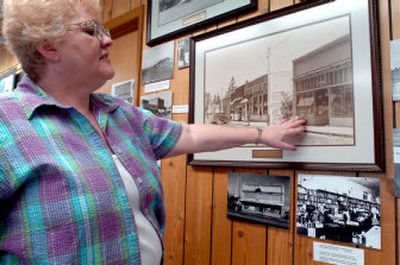Growth forces Post Falls Museum into uncertain future

Many old photographs line the walls of the Post Falls Museum – some showing Frederick Post’s lumber mill. Other pictures in the tiny building on Fourth Avenue depict the city’s bustling downtown in the early 1900s.
But as city leaders look to write the next chapter of Post Falls’ history, plans for a new downtown corridor threaten the museum’s future.
The Post Falls Historical Society has been searching for a home for the museum for a year and a half, after learning a new City Hall project would leave them out in the cold. The museum is in the Malloy Building, a city-owned structure that is up for sale.
Society president Sharon Alexander said a recent meeting with Mayor Clay Larkin was “promising” and a new location might be in the works.
Setbacks in the City Hall project have bought the museum a little more time; it will remain in the Malloy Building until at least this fall, Alexander said.
Historical society members aren’t sure what happens after that. Alexander said Larkin suggested the museum may be able to take up residence in the Chapin Building, once a drug store at Fourth Avenue and Spokane Street, and now the location of the Post Falls Parks and Recreation Department.
Gary Young, Post Falls community development director, said city officials want the museum to remain in what they believe will become the downtown corridor.
“That’s a perfect use for what the master plan calls for in the downtown area,” Young said.
He said the museum would be part of what makes the city unique.
Society members believe a museum links longtime residents with people just moving to the area.
A City Council meeting Tuesday night will shed more light on the situation, said society treasurer Vickie Eagle, who also met with Larkin last week.
The city’s development hinges on a proposed contract to begin an initial design and energy modeling phase for a new City Hall, which should be done by the fall.
Once the council decides on the contract, the society will know its next steps.
The search for a new museum site over the past 18 months has had promising moments for society members, said Kim Brown, former president of the group. One potential location included the 99-year-old Lindberg family home at Sixth Avenue and Frederick Street.
But Brown said the developers who own the building hit snags in their project, and there is no way of knowing when a decision will be made on that property.
Harry Green, who for years has envisioned a city core blossoming from his Post Falls Landing development, also considered helping the society.
But his project also seems to be going slow, society members said.
“Right now we know that we are in a temporary facility,” Alexander said.
Eagle said the Chapin Building is an interesting location for the museum; pictures of the old drug store are part of the museum’s current collection. If the museum were relocated to the old Chapin Drug store, the society would try to remodel the front of the building to its original state and place it on the National Register of Historic Places, she said.
“That’s one building we’d hate to ever see taken down because the history behind it is incredible,” Eagle said.
The mayor told the society that if someone were to buy the Malloy Building from the city, he would ask for 60 to 90 days to relocate the museum or pack it up and place everything in storage, Alexander said.
That’s a strong possiblity, she said. As construction starts on the new city hall and old city buildings are sold, it may take as long as 15 months before the society can take over the Chapin Building.
Society members also are discussing purchasing land and building a permanent location but are worried about the cost, including property values.
“When we were young,” Eagle said, “nobody even wanted to buy land by the river.”
Alexander said society members have also expressed disdain for spending more money on renting a facility.
“When they start (construction), we’re going to have to move,” she said. “We’ll just play it by ear.”